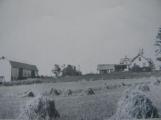14
Don and Margaret Beeler on former Malcolm property21st century
Highway 6 Brule, Nova Scotia, Canada
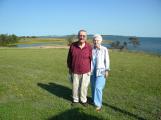 Credits:
Credits:Creamery Square Heritage Society
15
2. The Malcom FarmMargaret Beeler nee Malcom grew up on the Malcom farm which today is under a different owner who keeps beef cattle. The original farm, which lies across the road from where Margaret and her husband Don now live, originated in about 1855 when Thomas Malcolm bought 150 acres from James Semple and built the original farmhouse. He and his family lived in a small hut while the house was built. Thomas cleared the land and grew grain, hay and pasture for his Durham cows. In 1880 Thomas divided the land into lots of 75 acres for his two sons, Robert and William, who each gave him $1200.00 in return.
Robert married again after the death of his first wife and in all had ten children. The original barn blew down in a windstorm and another was built in 1910. The barn was a 'split level' on sloping land. The lower floor stabled the two horses, had the stanchions for milking the cattle, calf pens, and a root cellar into which turnips were dropped from a trapdoor in the ceiling. On the upper floor were the hay mows, grain store and space for wagons. A pig building was attached to the barn for 25 - 30 pigs, which were fed on skim milk. Only part of the original house and the pig barn remains on the site today. Manure was automatically moved outside the barn by shovelling it into a container which was then taken by an overhead track to the outside. Here it collected until taken to be spread on the fields.
17
Robert Malcom passed on the farm to one of his ten children, Arthur Malcolm in 1923. Arthur became one of the premier farmers in Nova Scotia and he bred and developed a fine herd of Jersey cattle. Unfortunately, a test found the herd to be positive for tuberculosis , so they all had to be destroyed. Dishearteningly, this test was later shown to be incorrect, however Arthur started again, and produced prize winning Jersey cows - some of the best in Canada, winning top awards at the Royal Winter Fair in 1950.Arthur was meticulous with his record keeping, maintaining daily the weight of the milk and using the Babcock test to measure the butterfat content . In the late 1940's a tractor replaced the horses. During the Depression years cars were rarely used because of the price of gas. Highway 6 which runs past the property to Pictou, was not paved until after World War II.
18
Looking across the former Malcolm farm21st century
Highway 6 Brule, Nova Scotia, Canada
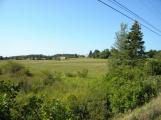 Credits:
Credits:Creamery Square Heritage Society
19
Farmhouse at Ross farm19th century
Brule Point Road, Brule, Nova Scotia, Canada
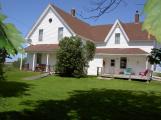 Credits:
Credits:Shirley Brinkhurst
20
3. The Ross Farm in BruleKatherine Ross worked at the Creamery in the office for 35 years and she and her husband also owned a farm in Brule. The farm was about 120 acres, including woodland. They had twenty Jersey cows and sent cream to the Creamery. In the beginning they took the cream into the Creamery themselves before truck collection began.
In addition, about 75 pigs were kept, fattened and sold, being sent by truck and train to the abattoir in Truro. Grain and hay was also grown and they shared the use of a combine harvester with other farmers.
Katherine's husband is now deceased, but she still lives on the farm in the farmhouse.
21
Barn at Ross farm19th century
Brule Point Road, Brule, Nova Scotia, Canada
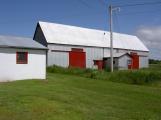 Credits:
Credits:Creamery Square Heritage Society
22
Satellite image of Cock and Sylvia Ross farms20th century
Highway 6 Brule, Nova Scotia, Canada
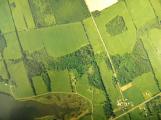 Credits:
Credits:Land Registry Office, Pictou Nova Scotia, Canada
23
4. The Cock FarmThe former Cock Farm is now a communal farm run by several young people, producing organically grown vegetables, which they sell locally. The group also has ambitions to expand into organic soft fruits and livestock. Some new houses have been built on the property to house the 'co-operative' families
24
Farmhouse at Cock farm19th centrury
Waldegrave near Brule, Nova Scotia, Canada
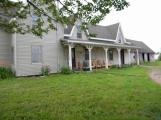 Credits:
Credits:Shirley Brinkhurst
25
Willis Cock's family owned the farm originally, his great grandfather moved to the farm in 1870. The farm was initially 100 acres and in the early 1930's another 100 acres, mainly of woodland, was bought. Willis' family had a herd of 16 cows as well as 10 of younger age and regularly sent cream to the Tatamagouche Creamery. On the site there was the farmhouse a large barn for cattle and horses with hay storage above and several smaller buildings for pigs, hens, the buggy and farm machinery.27
Willis recalls that most farms had many types of animals and that the number of cows depended on two factors: the quantity of hay produced as during the winters cows were kept indoors, and the ability of the family to hand-milk the cows.Many farmers planned to have their cows dry, or not producing much milk, in the winter and ready to milk well when they were on grass again, in the spring. This system reduced the amount of purchased feed needed and allowed the farmer to work away in the woods during the winter months. The distance to haul cream was also a factor, as trucks only collected in the summer months as the roads were poor in the winter. Horse and sleigh travel was necessary during these months.
Willis' family also worked in their own woods, cutting firewood, fence posts and a few logs. In addition, they also did custom grain grinding for other farmers. Everyone tried to have one cow milking to supply family needs.
